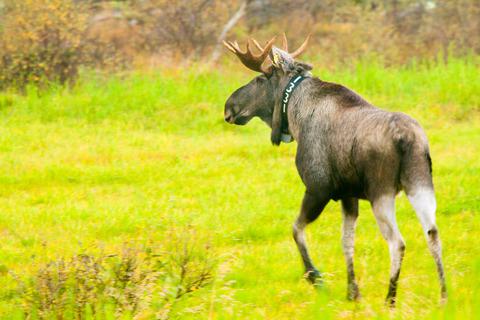当前位置:
X-MOL 学术
›
J. Anim. Ecol.
›
论文详情
Our official English website, www.x-mol.net, welcomes your
feedback! (Note: you will need to create a separate account there.)
Opposing fitness consequences of habitat use in a harvested moose population
Journal of Animal Ecology ( IF 3.5 ) Pub Date : 2020-04-28 , DOI: 10.1111/1365-2656.13221 Endre Grüner Ofstad 1 , Stine S Markussen 1 , Bernt-Erik Saether 1 , Erling J Solberg 2 , Morten Heim 2 , Hallvard Haanes 3 , Knut H Røed 4 , Ivar Herfindal 1
Journal of Animal Ecology ( IF 3.5 ) Pub Date : 2020-04-28 , DOI: 10.1111/1365-2656.13221 Endre Grüner Ofstad 1 , Stine S Markussen 1 , Bernt-Erik Saether 1 , Erling J Solberg 2 , Morten Heim 2 , Hallvard Haanes 3 , Knut H Røed 4 , Ivar Herfindal 1
Affiliation

|
Landscape changes are happening at an unprecedented pace, and together with high levels of wildlife harvesting humans have a large effect on wildlife populations. A thorough knowledge of their combined influence on individual fitness is important in order to understand factors affecting population dynamics. The goal of the study was to assess the individual consistency in the use of risky habitat types, and how habitat use was related to fitness components and life-history strategies. Using data from a closely monitored and harvested population of moose (Alces alces), we examined how individual variation in offspring size, reproduction, and survival was related to the use of open grasslands; a habitat type that offers high-quality forage during summer, but at the cost of being more exposed to hunters in autumn. Use of this habitat type may therefore involve a trade-off between high mortality risk and forage maximization. There was high repeatability in habitat use, which suggest consistent behaviour within individuals. Offspring number and weight was positively related to the mothers' use of open grasslands, whereas the probability of surviving the subsequent harvest season was negatively related to the use of the same habitat type. As a consequence, we found a non-significant relationship between habitat use and lifetime fitness. The study suggest that harvesting, even if intended to be nonselective with regard to phenotypes, may be selective towards animals with specific behaviour and life-history strategies. As a consequence, harvesting can alter the life-history composition of the population and target life-history strategies that would be beneficial for individual fitness and population growth in the absence of hunting.
中文翻译:

在收获的驼鹿种群中反对栖息地使用的健康后果
景观变化正在以前所未有的速度发生,加上人类大量捕捞野生动物,对野生动物种群产生了巨大影响。全面了解它们对个体健康的综合影响对于了解影响种群动态的因素很重要。该研究的目的是评估个体在使用危险栖息地类型时的一致性,以及栖息地使用与健康成分和生活史策略之间的关系。使用来自密切监测和收获的驼鹿(Alces alces)种群的数据,我们研究了后代大小、繁殖和存活的个体差异与开放草原的使用之间的关系;一种在夏季提供优质草料的栖息地类型,但代价是在秋季更容易接触到猎人。因此,使用这种栖息地类型可能涉及高死亡率风险和草料最大化之间的权衡。栖息地使用具有很高的可重复性,这表明个体内部的行为一致。后代数量和体重与母亲使用开阔草地呈正相关,而在随后的收获季节幸存的概率与使用相同栖息地类型呈负相关。因此,我们发现栖息地利用与终生健康之间没有显着关系。该研究表明,即使有意对表型进行非选择性捕捞,也可能对具有特定行为和生活史策略的动物具有选择性。作为结果,
更新日期:2020-04-28
中文翻译:

在收获的驼鹿种群中反对栖息地使用的健康后果
景观变化正在以前所未有的速度发生,加上人类大量捕捞野生动物,对野生动物种群产生了巨大影响。全面了解它们对个体健康的综合影响对于了解影响种群动态的因素很重要。该研究的目的是评估个体在使用危险栖息地类型时的一致性,以及栖息地使用与健康成分和生活史策略之间的关系。使用来自密切监测和收获的驼鹿(Alces alces)种群的数据,我们研究了后代大小、繁殖和存活的个体差异与开放草原的使用之间的关系;一种在夏季提供优质草料的栖息地类型,但代价是在秋季更容易接触到猎人。因此,使用这种栖息地类型可能涉及高死亡率风险和草料最大化之间的权衡。栖息地使用具有很高的可重复性,这表明个体内部的行为一致。后代数量和体重与母亲使用开阔草地呈正相关,而在随后的收获季节幸存的概率与使用相同栖息地类型呈负相关。因此,我们发现栖息地利用与终生健康之间没有显着关系。该研究表明,即使有意对表型进行非选择性捕捞,也可能对具有特定行为和生活史策略的动物具有选择性。作为结果,











































 京公网安备 11010802027423号
京公网安备 11010802027423号